Wei Wen
ASPD: Unlocking Adaptive Serial-Parallel Decoding by Exploring Intrinsic Parallelism in LLMs
Aug 12, 2025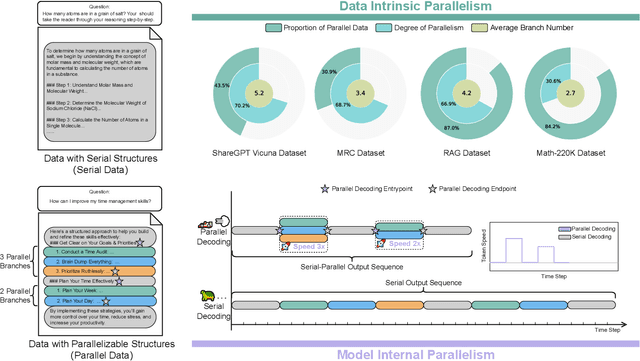
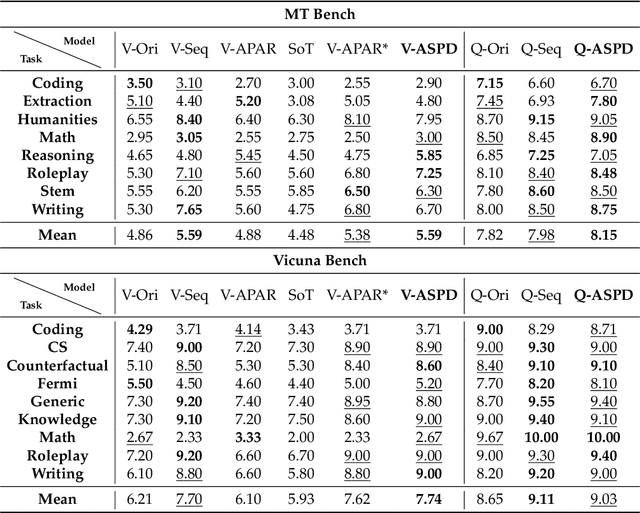
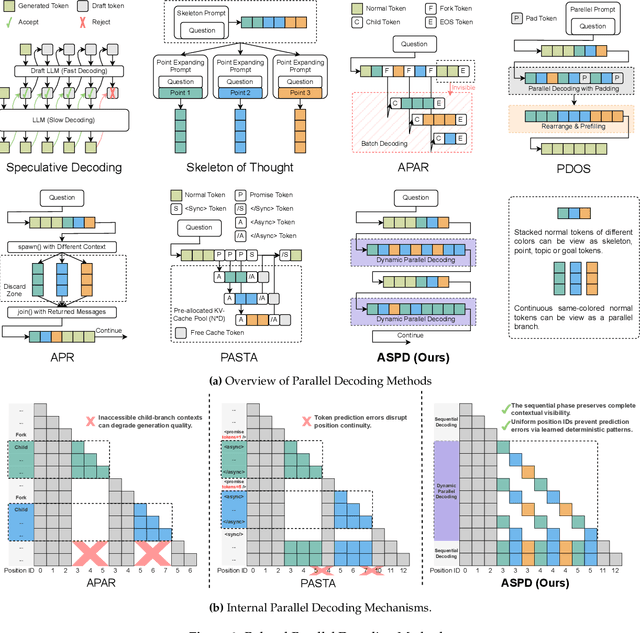

Abstract:The increasing scale and complexity of large language models (LLMs) pose significant inference latency challenges, primarily due to their autoregressive decoding paradigm characterized by the sequential nature of next-token prediction. By re-examining the outputs of autoregressive models, we observed that some segments exhibit parallelizable structures, which we term intrinsic parallelism. Decoding each parallelizable branch simultaneously (i.e. parallel decoding) can significantly improve the overall inference speed of LLMs. In this paper, we propose an Adaptive Serial-Parallel Decoding (ASPD), which addresses two core challenges: automated construction of parallelizable data and efficient parallel decoding mechanism. More specifically, we introduce a non-invasive pipeline that automatically extracts and validates parallelizable structures from the responses of autoregressive models. To empower efficient adaptive serial-parallel decoding, we implement a Hybrid Decoding Engine which enables seamless transitions between serial and parallel decoding modes while maintaining a reusable KV cache, maximizing computational efficiency. Extensive evaluations across General Tasks, Retrieval-Augmented Generation, Mathematical Reasoning, demonstrate that ASPD achieves unprecedented performance in both effectiveness and efficiency. Notably, on Vicuna Bench, our method achieves up to 3.19x speedup (1.85x on average) while maintaining response quality within 1% difference compared to autoregressive models, realizing significant acceleration without compromising generation quality. Our framework sets a groundbreaking benchmark for efficient LLM parallel inference, paving the way for its deployment in latency-sensitive applications such as AI-powered customer service bots and answer retrieval engines.
RocketEval: Efficient Automated LLM Evaluation via Grading Checklist
Mar 07, 2025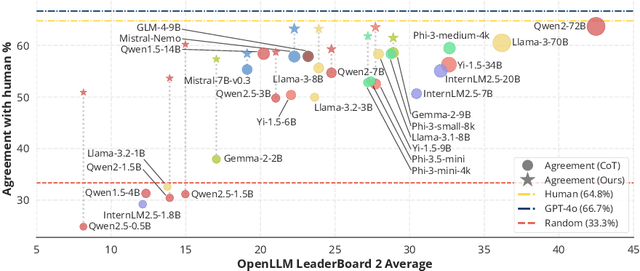
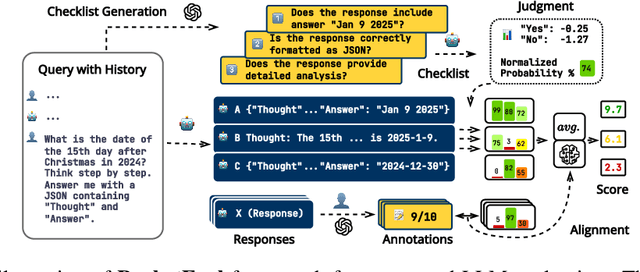
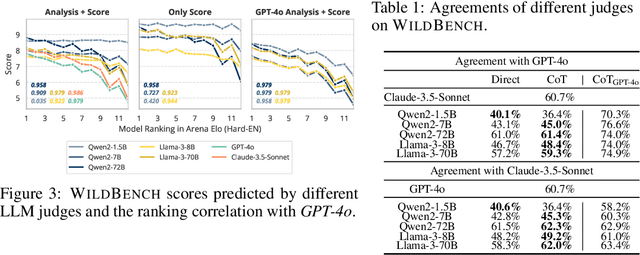
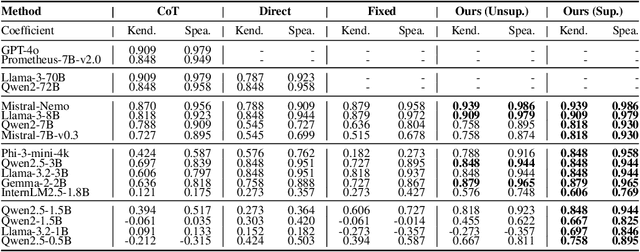
Abstract:Evaluating large language models (LLMs) in diverse and challenging scenarios is essential to align them with human preferences. To mitigate the prohibitive costs associated with human evaluations, utilizing a powerful LLM as a judge has emerged as a favored approach. Nevertheless, this methodology encounters several challenges, including substantial expenses, concerns regarding privacy and security, and reproducibility. In this paper, we propose a straightforward, replicable, and accurate automated evaluation method by leveraging a lightweight LLM as the judge, named RocketEval. Initially, we identify that the performance disparity between lightweight and powerful LLMs in evaluation tasks primarily stems from their ability to conduct comprehensive analyses, which is not easily enhanced through techniques such as chain-of-thought reasoning. By reframing the evaluation task as a multi-faceted Q&A using an instance-specific checklist, we demonstrate that the limited judgment accuracy of lightweight LLMs is largely attributes to high uncertainty and positional bias. To address these challenges, we introduce an automated evaluation process grounded in checklist grading, which is designed to accommodate a variety of scenarios and questions. This process encompasses the creation of checklists, the grading of these checklists by lightweight LLMs, and the reweighting of checklist items to align with the supervised annotations. Our experiments carried out on the automated evaluation benchmarks, MT-Bench and WildBench datasets, reveal that RocketEval, when using Gemma-2-2B as the judge, achieves a high correlation (0.965) with human preferences, which is comparable to GPT-4o. Moreover, RocketEval provides a cost reduction exceeding 50-fold for large-scale evaluation and comparison scenarios. Our code is available at https://github.com/Joinn99/RocketEval-ICLR .
InterFormer: Towards Effective Heterogeneous Interaction Learning for Click-Through Rate Prediction
Nov 15, 2024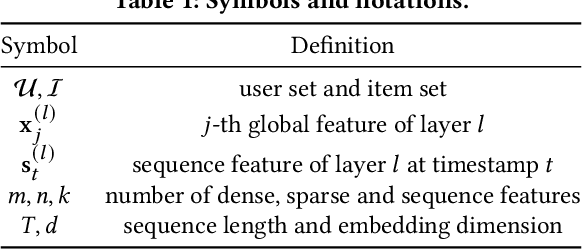
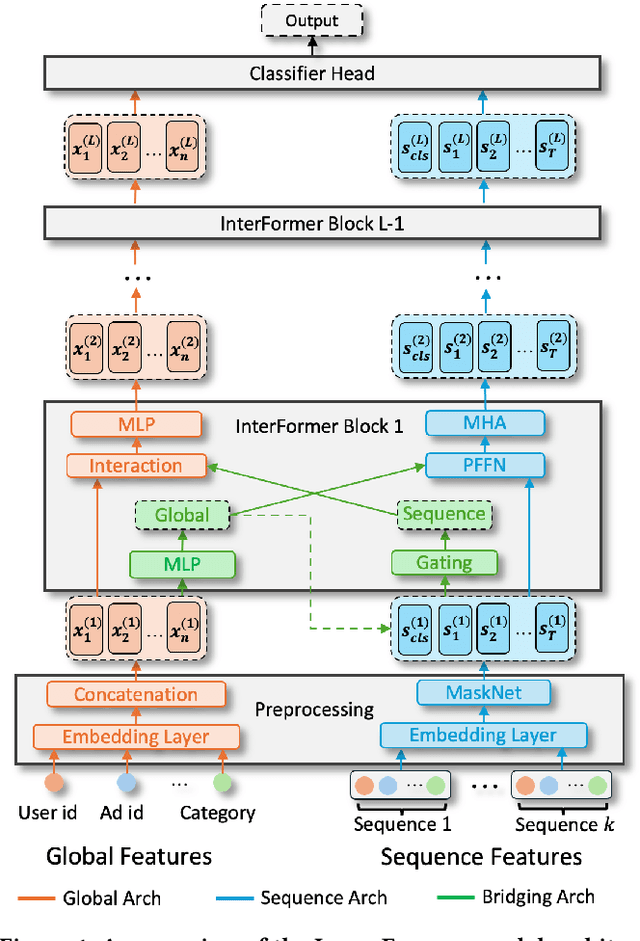

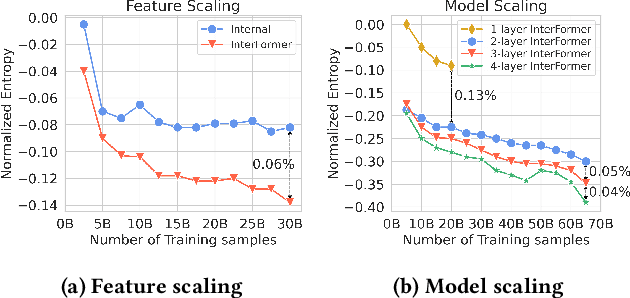
Abstract:Click-through rate (CTR) prediction, which predicts the probability of a user clicking an ad, is a fundamental task in recommender systems. The emergence of heterogeneous information, such as user profile and behavior sequences, depicts user interests from different aspects. A mutually beneficial integration of heterogeneous information is the cornerstone towards the success of CTR prediction. However, most of the existing methods suffer from two fundamental limitations, including (1) insufficient inter-mode interaction due to the unidirectional information flow between modes, and (2) aggressive information aggregation caused by early summarization, resulting in excessive information loss. To address the above limitations, we propose a novel module named InterFormer to learn heterogeneous information interaction in an interleaving style. To achieve better interaction learning, InterFormer enables bidirectional information flow for mutually beneficial learning across different modes. To avoid aggressive information aggregation, we retain complete information in each data mode and use a separate bridging arch for effective information selection and summarization. Our proposed InterFormer achieves state-of-the-art performance on three public datasets and a large-scale industrial dataset.
Towards Automated Model Design on Recommender Systems
Nov 12, 2024Abstract:The increasing popularity of deep learning models has created new opportunities for developing AI-based recommender systems. Designing recommender systems using deep neural networks requires careful architecture design, and further optimization demands extensive co-design efforts on jointly optimizing model architecture and hardware. Design automation, such as Automated Machine Learning (AutoML), is necessary to fully exploit the potential of recommender model design, including model choices and model-hardware co-design strategies. We introduce a novel paradigm that utilizes weight sharing to explore abundant solution spaces. Our paradigm creates a large supernet to search for optimal architectures and co-design strategies to address the challenges of data multi-modality and heterogeneity in the recommendation domain. From a model perspective, the supernet includes a variety of operators, dense connectivity, and dimension search options. From a co-design perspective, it encompasses versatile Processing-In-Memory (PIM) configurations to produce hardware-efficient models. Our solution space's scale, heterogeneity, and complexity pose several challenges, which we address by proposing various techniques for training and evaluating the supernet. Our crafted models show promising results on three Click-Through Rates (CTR) prediction benchmarks, outperforming both manually designed and AutoML-crafted models with state-of-the-art performance when focusing solely on architecture search. From a co-design perspective, we achieve 2x FLOPs efficiency, 1.8x energy efficiency, and 1.5x performance improvements in recommender models.
* Accepted in ACM Transactions on Recommender Systems. arXiv admin note: substantial text overlap with arXiv:2207.07187
CubicML: Automated ML for Distributed ML Systems Co-design with ML Prediction of Performance
Sep 06, 2024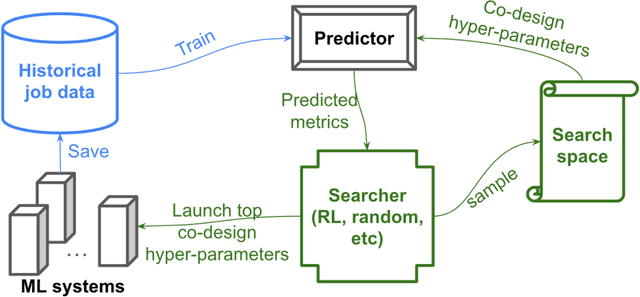
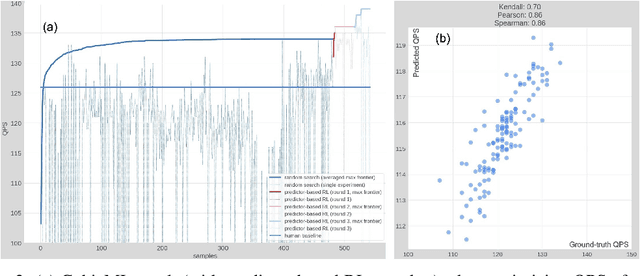
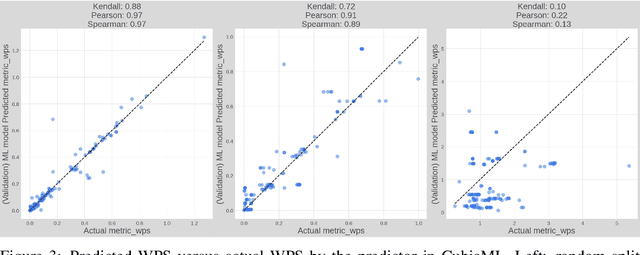
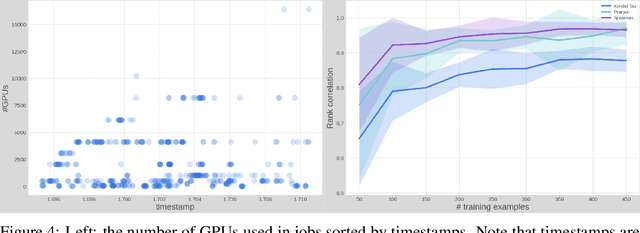
Abstract:Scaling up deep learning models has been proven effective to improve intelligence of machine learning (ML) models, especially for industry recommendation models and large language models. The co-design of distributed ML systems and algorithms (to maximize training performance) plays a pivotal role for its success. As it scales, the number of co-design hyper-parameters grows rapidly which brings challenges to feasibly find the optimal setup for system performance maximization. In this paper, we propose CubicML which uses ML to automatically optimize training performance of distributed ML systems. In CubicML, we use a ML model as a proxy to predict the training performance for search efficiency and performance modeling flexibility. We proved that CubicML can effectively optimize training speed of in-house ads recommendation models and large language models at Meta.
Serialized Point Mamba: A Serialized Point Cloud Mamba Segmentation Model
Jul 17, 2024



Abstract:Point cloud segmentation is crucial for robotic visual perception and environmental understanding, enabling applications such as robotic navigation and 3D reconstruction. However, handling the sparse and unordered nature of point cloud data presents challenges for efficient and accurate segmentation. Inspired by the Mamba model's success in natural language processing, we propose the Serialized Point Cloud Mamba Segmentation Model (Serialized Point Mamba), which leverages a state-space model to dynamically compress sequences, reduce memory usage, and enhance computational efficiency. Serialized Point Mamba integrates local-global modeling capabilities with linear complexity, achieving state-of-the-art performance on both indoor and outdoor datasets. This approach includes novel techniques such as staged point cloud sequence learning, grid pooling, and Conditional Positional Encoding, facilitating effective segmentation across diverse point cloud tasks. Our method achieved 76.8 mIoU on Scannet and 70.3 mIoU on S3DIS. In Scannetv2 instance segmentation, it recorded 40.0 mAP. It also had the lowest latency and reasonable memory use, making it the SOTA among point semantic segmentation models based on mamba.
SiGeo: Sub-One-Shot NAS via Information Theory and Geometry of Loss Landscape
Nov 22, 2023Abstract:Neural Architecture Search (NAS) has become a widely used tool for automating neural network design. While one-shot NAS methods have successfully reduced computational requirements, they often require extensive training. On the other hand, zero-shot NAS utilizes training-free proxies to evaluate a candidate architecture's test performance but has two limitations: (1) inability to use the information gained as a network improves with training and (2) unreliable performance, particularly in complex domains like RecSys, due to the multi-modal data inputs and complex architecture configurations. To synthesize the benefits of both methods, we introduce a "sub-one-shot" paradigm that serves as a bridge between zero-shot and one-shot NAS. In sub-one-shot NAS, the supernet is trained using only a small subset of the training data, a phase we refer to as "warm-up." Within this framework, we present SiGeo, a proxy founded on a novel theoretical framework that connects the supernet warm-up with the efficacy of the proxy. Extensive experiments have shown that SiGeo, with the benefit of warm-up, consistently outperforms state-of-the-art NAS proxies on various established NAS benchmarks. When a supernet is warmed up, it can achieve comparable performance to weight-sharing one-shot NAS methods, but with a significant reduction ($\sim 60$\%) in computational costs.
AutoML for Large Capacity Modeling of Meta's Ranking Systems
Nov 16, 2023
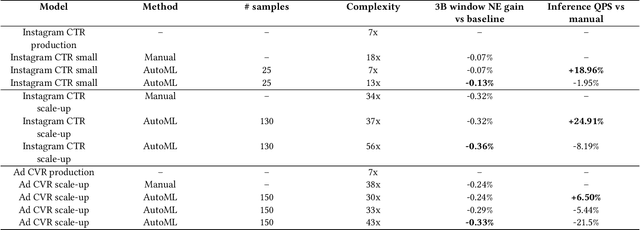
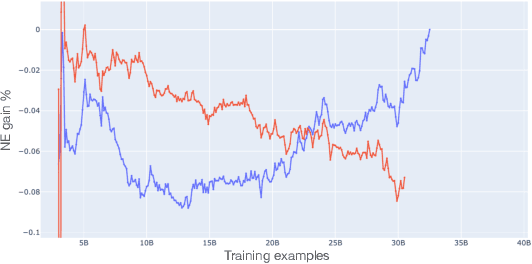

Abstract:Web-scale ranking systems at Meta serving billions of users is complex. Improving ranking models is essential but engineering heavy. Automated Machine Learning (AutoML) can release engineers from labor intensive work of tuning ranking models; however, it is unknown if AutoML is efficient enough to meet tight production timeline in real-world and, at the same time, bring additional improvements to the strong baselines. Moreover, to achieve higher ranking performance, there is an ever-increasing demand to scale up ranking models to even larger capacity, which imposes more challenges on the efficiency. The large scale of models and tight production schedule requires AutoML to outperform human baselines by only using a small number of model evaluation trials (around 100). We presents a sampling-based AutoML method, focusing on neural architecture search and hyperparameter optimization, addressing these challenges in Meta-scale production when building large capacity models. Our approach efficiently handles large-scale data demands. It leverages a lightweight predictor-based searcher and reinforcement learning to explore vast search spaces, significantly reducing the number of model evaluations. Through experiments in large capacity modeling for CTR and CVR applications, we show that our method achieves outstanding Return on Investment (ROI) versus human tuned baselines, with up to 0.09% Normalized Entropy (NE) loss reduction or $25\%$ Query per Second (QPS) increase by only sampling one hundred models on average from a curated search space. The proposed AutoML method has already made real-world impact where a discovered Instagram CTR model with up to -0.36% NE gain (over existing production baseline) was selected for large-scale online A/B test and show statistically significant gain. These production results proved AutoML efficacy and accelerated its adoption in ranking systems at Meta.
Rankitect: Ranking Architecture Search Battling World-class Engineers at Meta Scale
Nov 14, 2023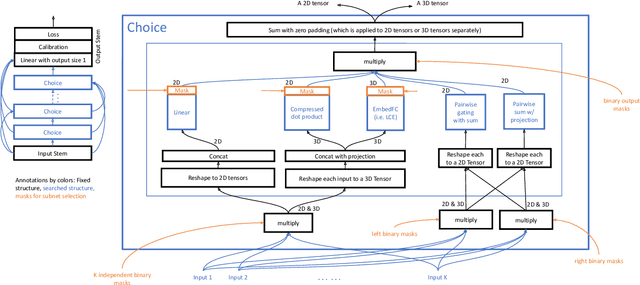

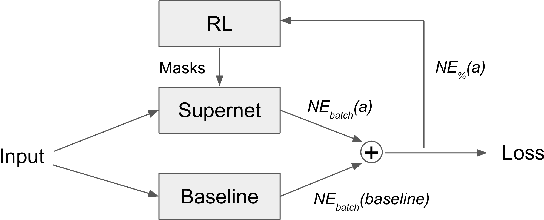

Abstract:Neural Architecture Search (NAS) has demonstrated its efficacy in computer vision and potential for ranking systems. However, prior work focused on academic problems, which are evaluated at small scale under well-controlled fixed baselines. In industry system, such as ranking system in Meta, it is unclear whether NAS algorithms from the literature can outperform production baselines because of: (1) scale - Meta ranking systems serve billions of users, (2) strong baselines - the baselines are production models optimized by hundreds to thousands of world-class engineers for years since the rise of deep learning, (3) dynamic baselines - engineers may have established new and stronger baselines during NAS search, and (4) efficiency - the search pipeline must yield results quickly in alignment with the productionization life cycle. In this paper, we present Rankitect, a NAS software framework for ranking systems at Meta. Rankitect seeks to build brand new architectures by composing low level building blocks from scratch. Rankitect implements and improves state-of-the-art (SOTA) NAS methods for comprehensive and fair comparison under the same search space, including sampling-based NAS, one-shot NAS, and Differentiable NAS (DNAS). We evaluate Rankitect by comparing to multiple production ranking models at Meta. We find that Rankitect can discover new models from scratch achieving competitive tradeoff between Normalized Entropy loss and FLOPs. When utilizing search space designed by engineers, Rankitect can generate better models than engineers, achieving positive offline evaluation and online A/B test at Meta scale.
DistDNAS: Search Efficient Feature Interactions within 2 Hours
Nov 01, 2023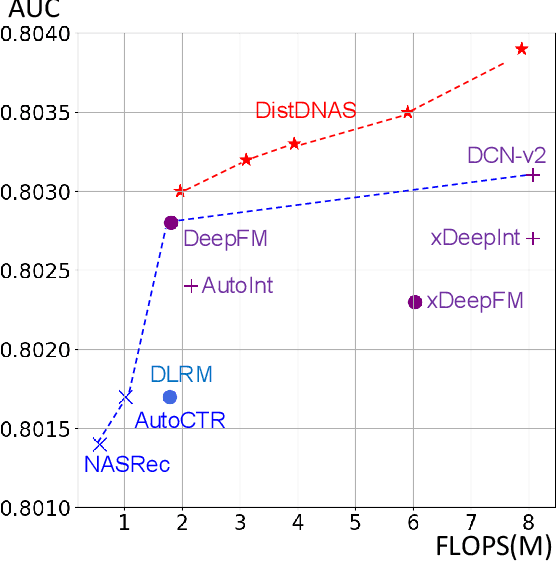



Abstract:Search efficiency and serving efficiency are two major axes in building feature interactions and expediting the model development process in recommender systems. On large-scale benchmarks, searching for the optimal feature interaction design requires extensive cost due to the sequential workflow on the large volume of data. In addition, fusing interactions of various sources, orders, and mathematical operations introduces potential conflicts and additional redundancy toward recommender models, leading to sub-optimal trade-offs in performance and serving cost. In this paper, we present DistDNAS as a neat solution to brew swift and efficient feature interaction design. DistDNAS proposes a supernet to incorporate interaction modules of varying orders and types as a search space. To optimize search efficiency, DistDNAS distributes the search and aggregates the choice of optimal interaction modules on varying data dates, achieving over 25x speed-up and reducing search cost from 2 days to 2 hours. To optimize serving efficiency, DistDNAS introduces a differentiable cost-aware loss to penalize the selection of redundant interaction modules, enhancing the efficiency of discovered feature interactions in serving. We extensively evaluate the best models crafted by DistDNAS on a 1TB Criteo Terabyte dataset. Experimental evaluations demonstrate 0.001 AUC improvement and 60% FLOPs saving over current state-of-the-art CTR models.
 Add to Chrome
Add to Chrome Add to Firefox
Add to Firefox Add to Edge
Add to Edge